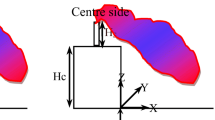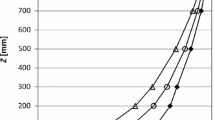Summary
A physical simulation in hydraulic channel has been performed, concerning the behaviour of buoyant and neutral plumes in the presence of a building of schematic shape placed near the stack. The effect of the aerodynamic wake, due to the stack itself and to the building, on the plume geometrical behaviour has been studied. This was done for various stack-building relative positions and letting both the ratios between exit and wind velocity and between stack and building height vary. The aim of the experiment was to confirm or better define the simple criteria normally applied for excluding in practical cases the occurrence of dangerous plume trapping phenomena. The results confirm these criteria and even suggest the possibility of relaxing them slightly. The simulation also allowed an indirect check of the validity of Briggs and Bryant plume rise models, as well as a study of the plume radius trendvs. distance from the source andvs. rise above the emission height. Particularly interesting in this context is the fact that the data put into evidence an enlarged plume spread in the cases of partial trapping with respect to the imperturbed cases and that the linear entrainment relationship between radius and rise is reassessed, with an entrainment parameter β=0.6 as in the atmosphere in the case of buoyant plumes.
Similar content being viewed by others
References
G. A. Briggs:Plume rise, U.S.A.E.C. (1969).
G. A. Briggs:Diffusion estimates for small emissions, unpublished ATDL No. 79 (Oak Ridge, TN, 1973).
D. Anfossi:Previsione dell'altezza effettiva dei pennacchi di fumo in atmosfera, Monografia del Progetto Finalizzato Ambiente del CNR (1982).
G. Brusasca, M. G. Morselli, S. Alessio, D. Anfossi andL. Briatore:Nuovo Cimento C,8, 259 (1985).
S. Alessio, D. Anfossi andG. Brusasca:Nuovo Cimento C,9, 788 (1986).
A. H. Huber andW. H. Snyder:Atmos. Environ.,16, 2837 (1982).
W. H. Snyder andR. E. Lawson jr.:Atmos. Environ.,10, 683 (1976).
R. P. Hosker jr.:Empirical estimation of the wake cavity size behind block-type structures inProceedings of the IV Symposium on Turbulence, Diffusion and Air Pollution, Reno, USA, (Amer. Meteor. Soc., Boston, Mass., 1979).
D. M. Slade:Meteorology and atomic energy, U.S.A.E.C. (1968).
G. C. Edwards:Plume rise modeling, inSecond Joint Conference on Applications of Air Pollution Meteorology (Amer. Meteor. Soc., Boston, Mass., 1980).
Author information
Authors and Affiliations
Rights and permissions
About this article
Cite this article
Alessio, S., Anfossi, D., Briatore, L. et al. Hydraulic simulation of the interaction between stack emissions and nearby buildings. Il Nuovo Cimento C 14, 41–51 (1991). https://doi.org/10.1007/BF02509256
Received:
Revised:
Issue Date:
DOI: https://doi.org/10.1007/BF02509256




